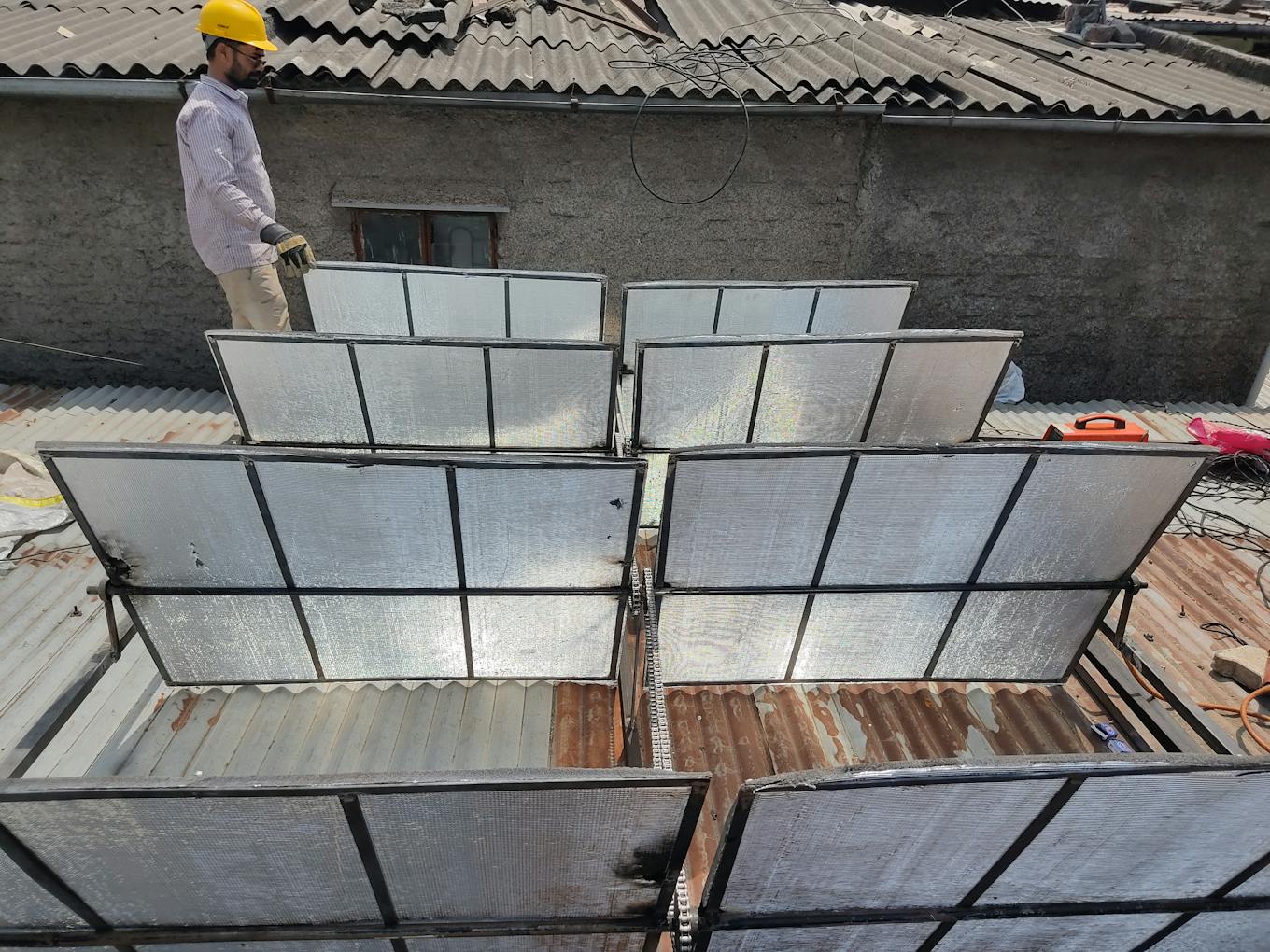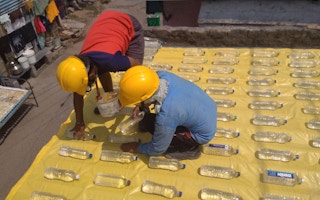When a group of engineers offered Rayissa Sayyad a simple mechanism to cool her 150 sq ft home that had a tin roof, she was more than a little incredulous.
To continue reading, subscribe to Eco‑Business.
There's something for everyone. We offer a range of subscription plans.
- Access our stories and receive our Insights Weekly newsletter with the free EB Member plan.
- Unlock unlimited access to our content and archive with EB Circle.
- Publish your content with EB Premium.
The tiny dwelling in the Shindevasti slum in the western Indian city of Pune got stifling hot by midday on summer days, forcing the family outdoors for most of the afternoon and evening. Could a chainwheel-pulley contraption to move a tinfoil rooftop sheet make a difference, she wondered.
“But our house did get considerably cooler, we could feel the difference distinctly,” said the 28-year-old, the second generation to live in the Shindevasti slum dwelling.
The rooftop installation in Sayyad’s home was part of a pilot project, covering 15 slum homes each in Pune and Bengaluru first, then Delhi and Mumbai, to develop rooftop retrofits for low-cost, sustainable cooling.
Between October 2020 and April 2022, cBalance Solutions, the Mumbai-based sustainability consultancy behind this “informal housing thermal comfort” project, conducted multiple rounds of discussions and trials with local communities to evolve a tested suite of workable solutions that reduce temperatures inside slum homes.
A first phase of research has been completed, and a second phase of installations is currently underway in Mumbai and Coimbatore in southern India.
The need for low-cost cooling
The success of the pilot project, its plans for scaling up and Rayissa Sayyad’s hope for a more comfortable summer this year are significant because professionally designed housing is not the norm in rural or urban India. In Mumbai, for example, nearly 60 per cent of the city lives in informal settlements. As average temperatures rise, this population is disproportionately affected by heat stress — their homes are congested, poorly ventilated and without the means to counter heat from solar radiation. The poor also have less access to reliable electricity supply and cooling systems.
This situation is mirrored across the developing world - from Kibera in Kenya’s Nairobi to the favelas of Brazil, and from Ciuddad Nezahualcoyotl in Mexico City to Tondo in Manila, slum dwellers are among those at the highest risk of heat exposure.
Rising temperatures raise the risk of death, and research has found that globally, over 5 million people died on an average each year between 2000 and 2019 due to extreme temperatures. In India, as in the rest of the developing world, the urban poor are at the frontiers of this climate risk.
“We want to address the glaring lack of inclusive visioning while co-creating and pilot-testing design solutions to address the legitimate cooling needs of marginalised people who occupy some of the most poorly built informal housing in India’s cities,” said Vivek Gilani, founder and managing director of cBalance Solutions. He said their “listening workshops” in the early stages, in which women from the communities played a central role in articulating how they used space, what family members’ (sometimes competing) needs were, and how interventions might help.
The retrofit plans now set to be scaled up are smart-engineering solutions including aluminium foil sheets used as movable daytime radiation barriers for walls and roofs; lightweight rooftop vegetation; and a high-emissivity plaster of barite (a white mineral that is used in some cement mixes) installed on walls.
The early results that have been recorded are promising.
A rooftop kitchen garden has made Jira Lal’s house in Shindevasti cooler by at least 4 or 5 degrees Celsius on average. “We removed the brick-bed because it was too heavy for the roof, and replaced it with grow bags [lightweight bags used to grow plants],” he said. His harvest includes eggplants and assorted greens every week or so, which he often shares with his neighbours.
Shweta Damle of the non-profit Habitat and Livelihood Welfare Association, which is partnering with cBalance for the retrofitting work currently afoot in a slum in Bandra in Mumbai, said the loss of workdays due to extreme heat and related health issues were visibly on the rise among the communities they work with. “The State’s climate change preparedness plans do not take into account the very poor and the impact on their livelihoods,” she said. “These homegrown solutions for cooling are critical in that context.”
Evolving designs, and community participation
Over its two-year research phase, the project’s rooftop installation designs have evolved with a deeper understanding of slum housing’s unique challenges. For instance, some installations had to be entirely removed for home renovations, including the one on the Sayyads’ roof, posing the question of how to design future solutions that could be adjusted and made modular. Some designs were also refined through a combination of cutting-edge engineering and community-supplied common sense.
One of the most inventive solutions comprises discarded PET bottles filled with water laid out in a lattice and affixed to the roof. An important upgrade has already been effected – the team have shifted from using 500 ml bottles to larger ones, and a greater density of bottles in the lattice. This provides additional thermal mass—the ability of a building material to absorb, store and release heat—and, therefore, less absorption of solar radiation and more cooling.
Gilani said they are also experimenting with coating the bottles with cow dung, which could bring down temperatures by a further couple of degrees, and are looking to install barricades along the edges of the roofs to prevent accidents from dislodged bottles.
The rooftop gardens are among the most effective, but are also challenging to operate as maintaining the drip-irrigation system, mulching the soil and harvesting the produce must be undertaken daily. “The idea that just because they’re informal homes, their occupants must undertake these tasks—that approach wouldn’t do justice,” said Gilani, an engineer by training whose social activism spans fields ranging from the environment to election campaign transparency.
On the design board now is the idea of a professional maintenance contract or tie-ups with local gardeners, or more ergonomically designed rooftop gardens.
The most complex intervention was an “alufoil chain and sprocket”, a roller-chain system on a toothed wheel called a sprocket that can be operated from inside the house to move aluminium foil radiation-barriers fitted on the roof as per the sun’s position. Engineers have tried to improve this design by making the mechanism easier to operate, particularly for women. They’re considering a bicycle-pedal design to open and close the sheets, instead of a rope and pulley.

Panels of aluminium foil act as raditation barriers. They are operated with a rope and pulley mechanism installed inside the house. Image: cBalance Solutions.
cBalance is also hoping to partner with Mumbai-based non-profit Safai Bank, which works to recycle multi-laminated packaging (MLP) waste - a type of plastic widely used in packaging chips and other food items that forms the bulk of the plastic waste currently generated.
As Gilani sees it, if the panels fabricated by Safai Bank using MLP provide the same cooling results as industrial alufoil, they will be able to rope in local communities for recycling of plastic waste and fabrication of reflector sheets.
Using infrared devices to measure under-roof temperatures, the team have found, on average, that where temperatures were 39 to 40 degrees Celsius on summer afternoons under a bare tin roof, a dip of 6 to 10 degrees was evident during the hottest parts of the day, between 1 pm and 2 pm. The temperature studies will continue at new sites to get a more comprehensive set of results.
At three sites in Coimbatore and three in Chennai in southern India, cBalance is applying the same solutions on public buildings, all government schools and government-run child nutrition centres. This is through a partnership with GIZ, the German enterprise for international cooperation, and the state government of Tamil Nadu, which is home to Coimbatore and Chennai.
In each community where they’re working, cBalance have tied up with local non-governmental organisations, designers, architects, engineers, academicians, and fabrication professionals.
To scale up
The idea of providing sustainable cooling solutions in slums came to Gilani in 2017, from one of his mentors at Fairconditioning, an initiative he had co-founded to popularise sustainable cooling in architecture. Surendra Shah, a veteran structural cooling expert, brought to Fairconditioning the idea of using alufoil as a radiation barrier. The 90-year-old Shah’s Panasia Engineers continues to provide the project with technical support.
Gilani’s domestic help would often complain how difficult it was to sleep at night because her slum home remained nearly unlivable until past midnight. “They would hang around outside, on their phones, until it was cool enough to sleep,” he said. Other women living in slums in Pune told similar stories, adding that they’d also have to wake up early to queue up to collect water. Some said they were taking sleeping pills.
cBalance applied for assistance from the Fair Cooling Fund, set up by London-based climate innovations supporter Ashden along with the Clean Cooling Collaborative and ClimateWorks Foundation. They are now among eight organisations worldwide working on tackling extreme heat.
As they begin installations in Mumbai and Coimbatore, the 15-member cBalance team are ready to scale up, buoyed by grants from the Rocky Mountain Institute, among others.
Additionally, they are liaising with experts to create training programmes for women entrepreneurs and women’s cooperatives who can then be given seed capital to fabricate the solutions.
The pilot phase has generated a great deal of interest. A coalition of organisations in Bhuj, in the arid and hot western state of Gujarat, is working on similar interventions there, an initiative cBalance calls a sister venture. The rooftop gardens have evoked interest from groups working on food resilience too. The pressure to scale up rapidly is intense, said Gilani.
The team is now in discussions with the Alliance for an Energy Efficient Economy (AEEE), which supports policy implementation in energy efficiency through a not-for-profit approach, to study how their solutions may be viewed as health interventions rather than housing design ones. This approach could attract city and state governments to adopt similar solutions at scale.
“Housing is a vexed subject,” Gilani said, “but health would be a requisite part of cities’ proactive measures in climate action plans or heat action plans.”
Kavitha Iyer is an independent journalist and author of the award-winning book, Landscapes Of Loss: The Story Of An Indian Drought. She lives in Mumbai.










